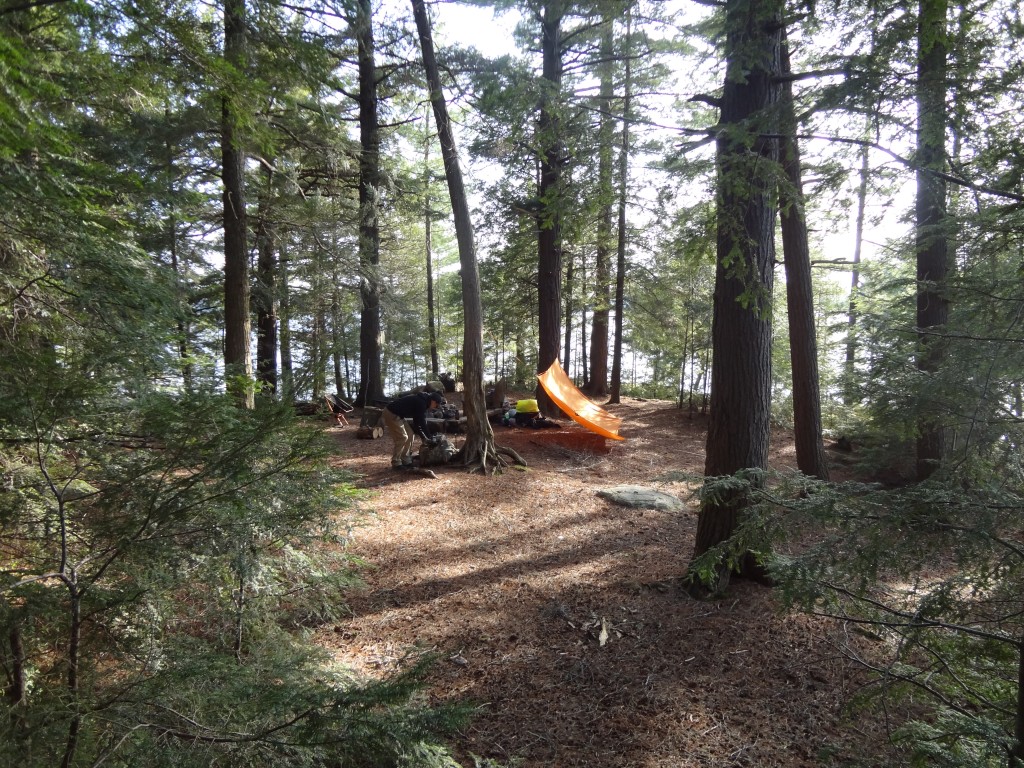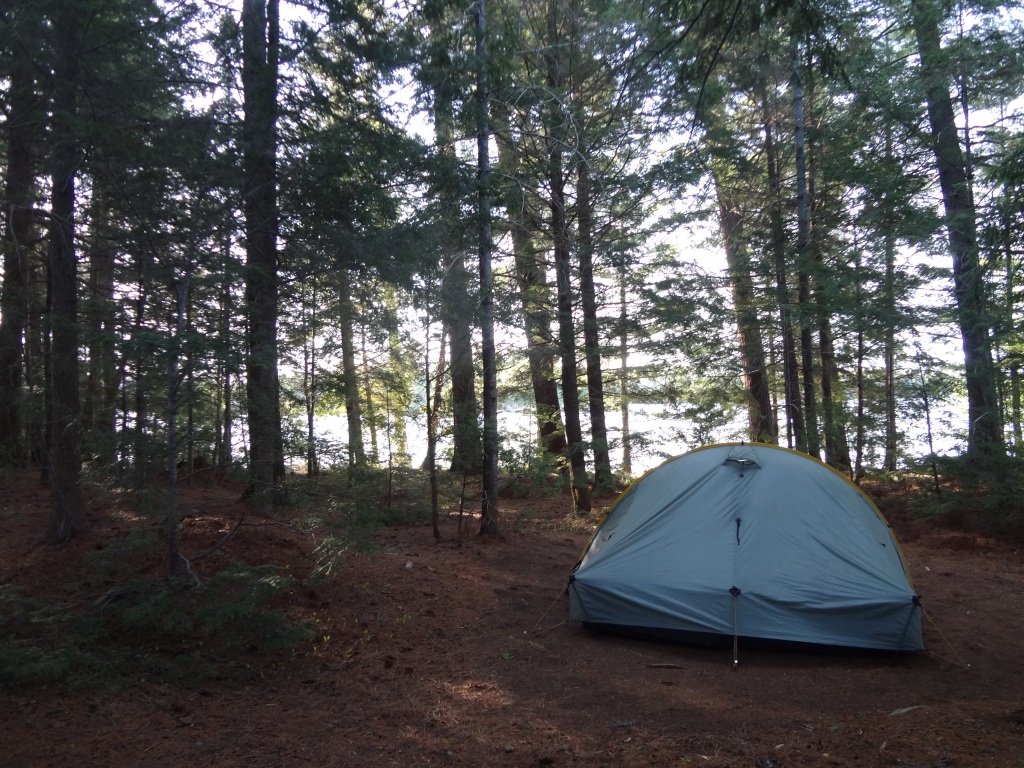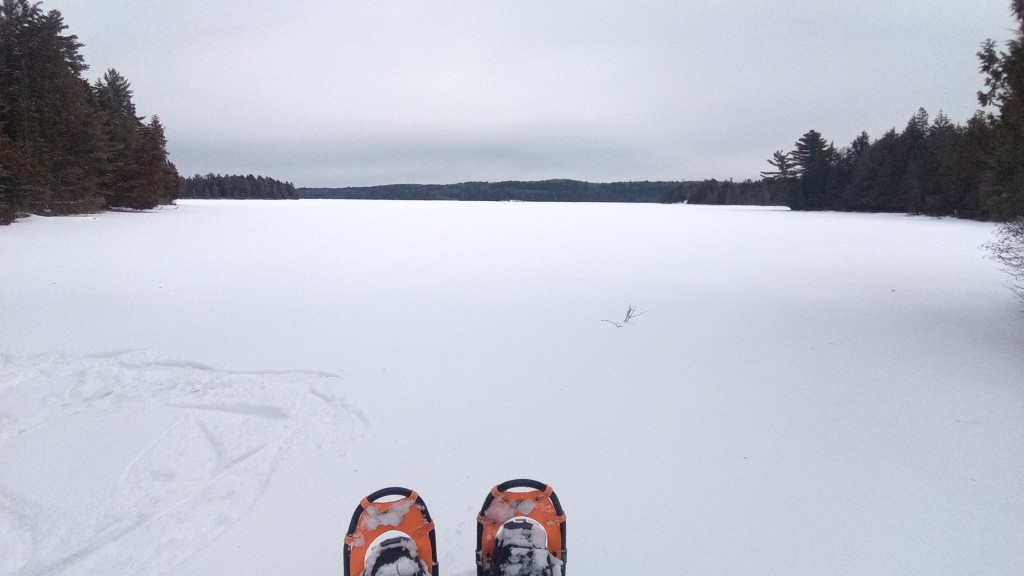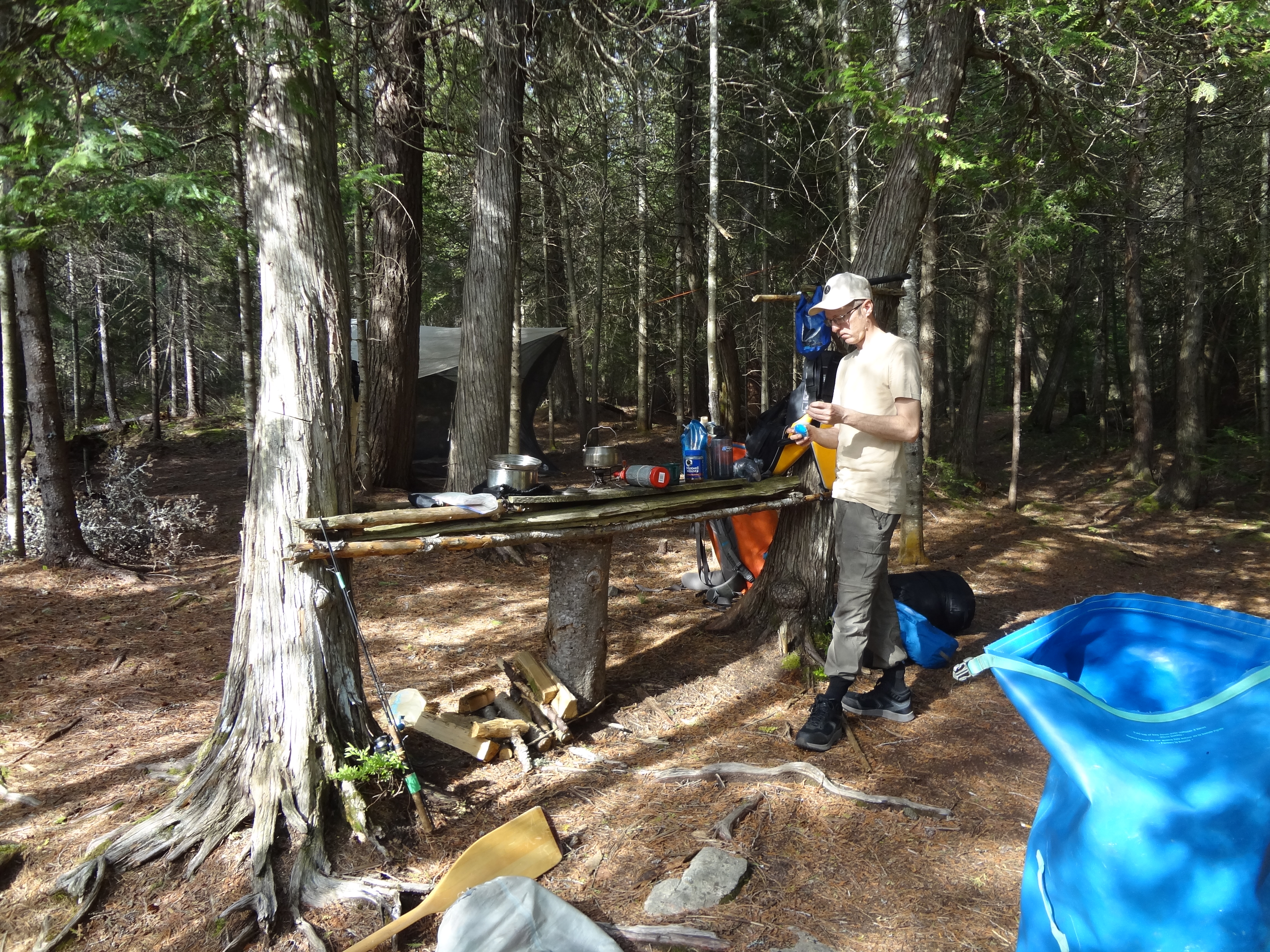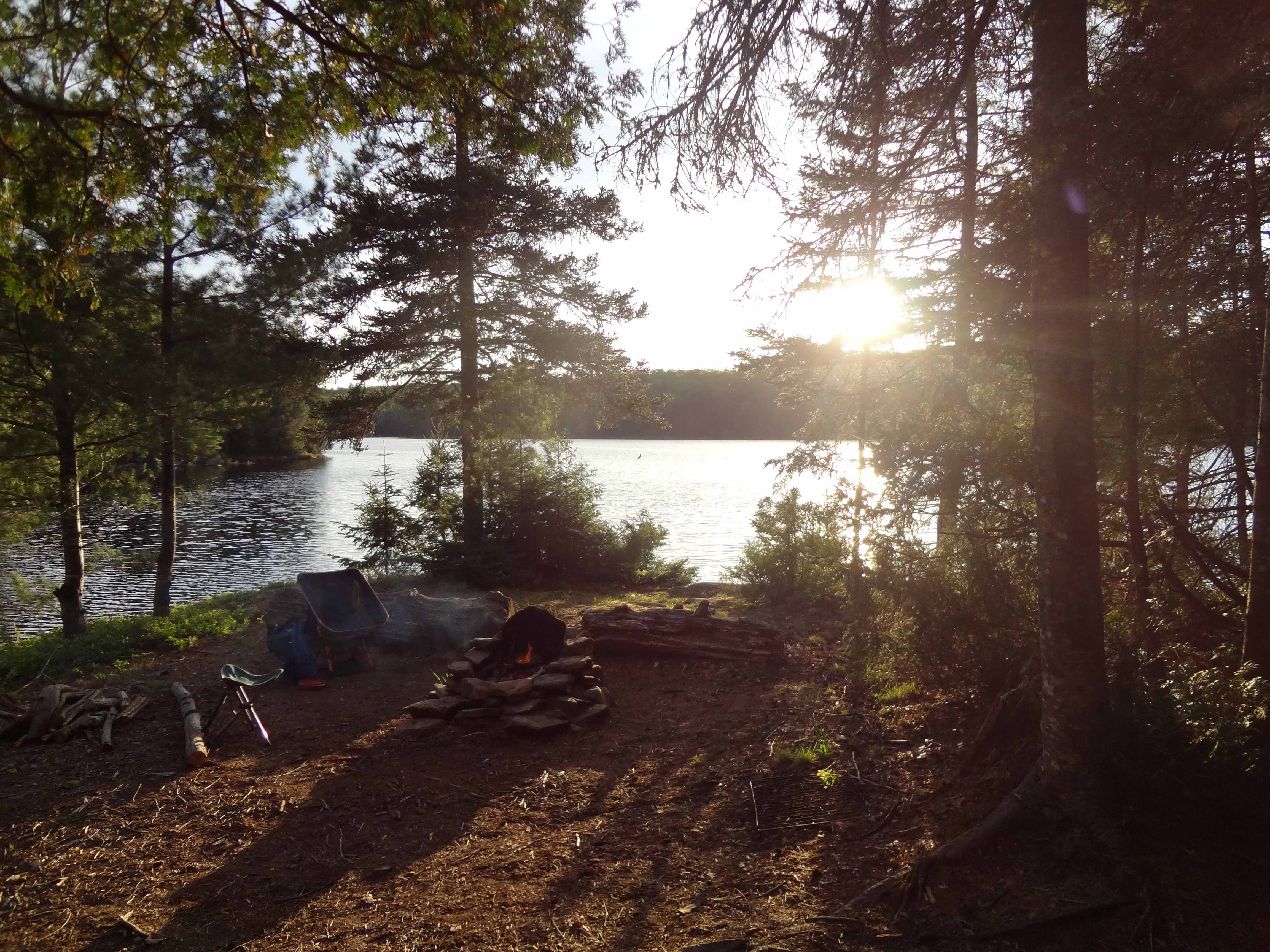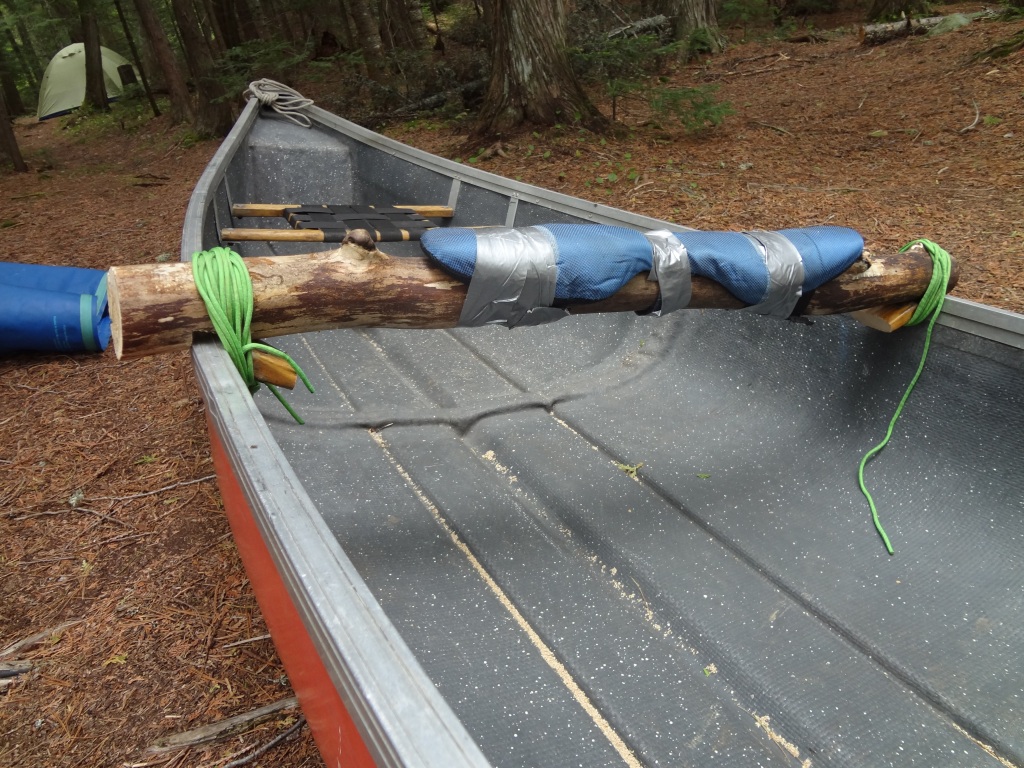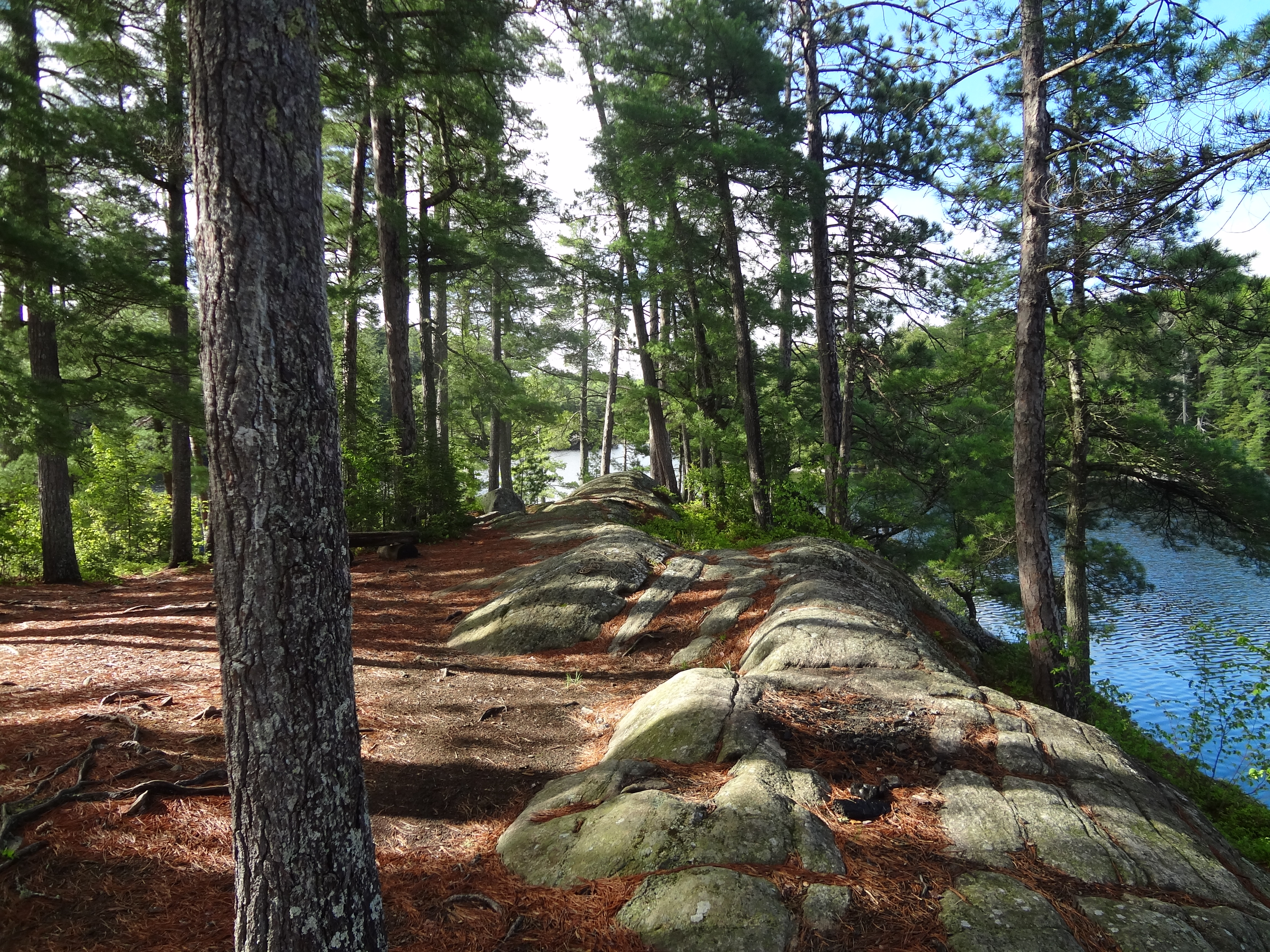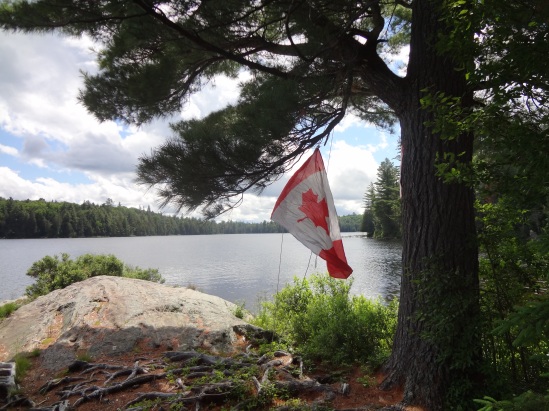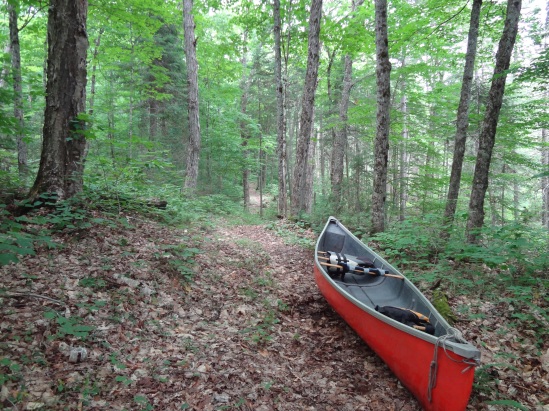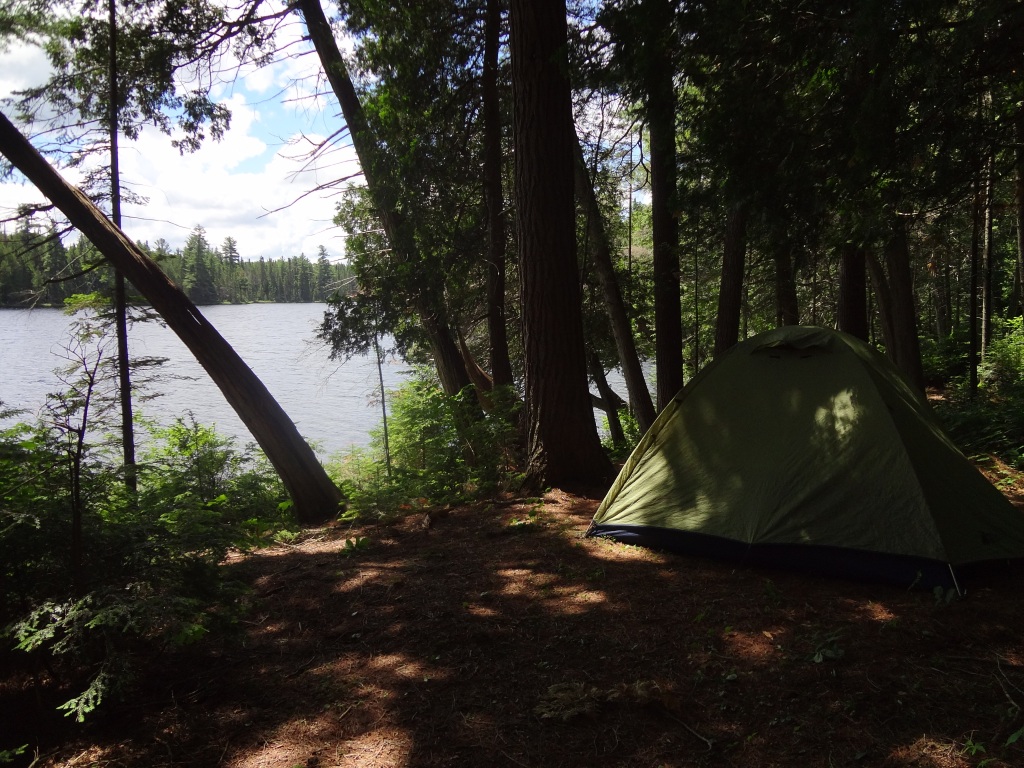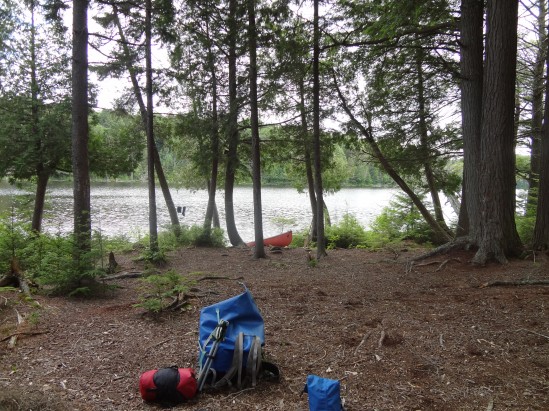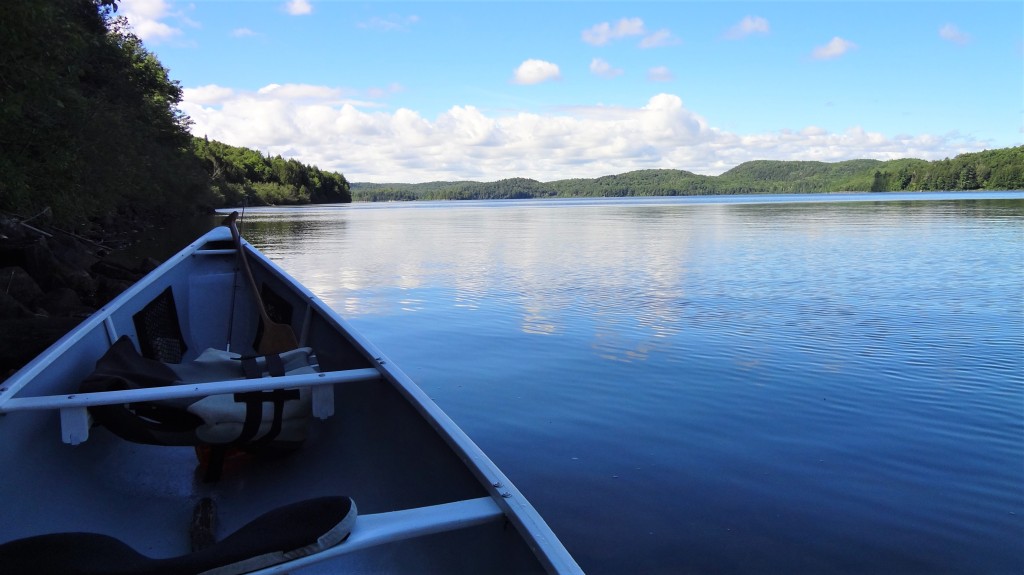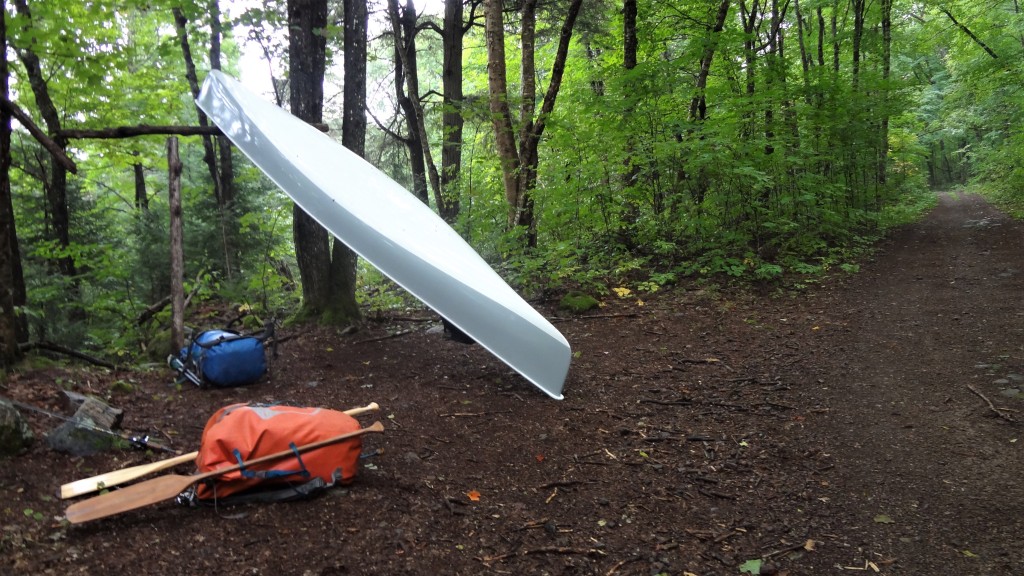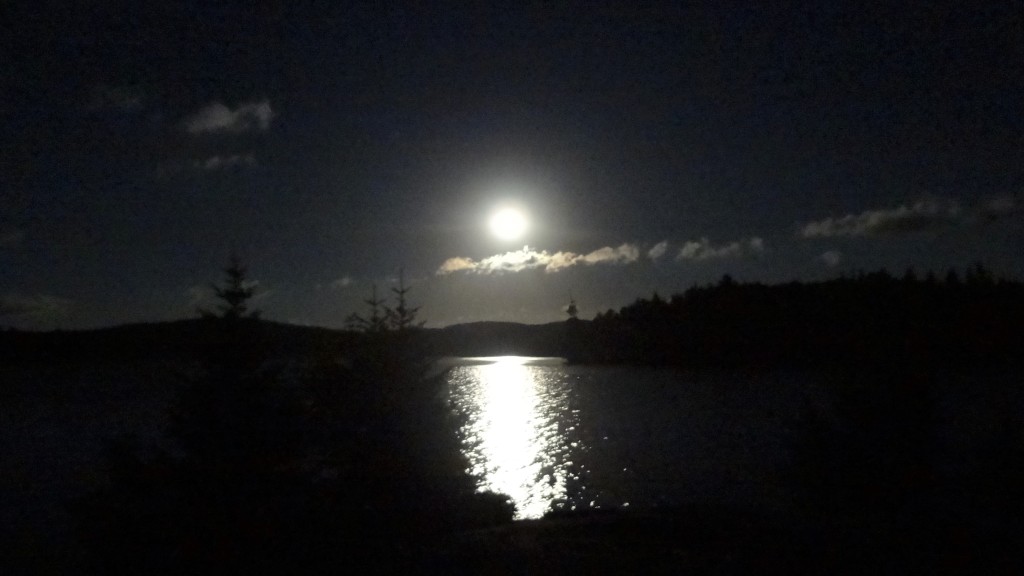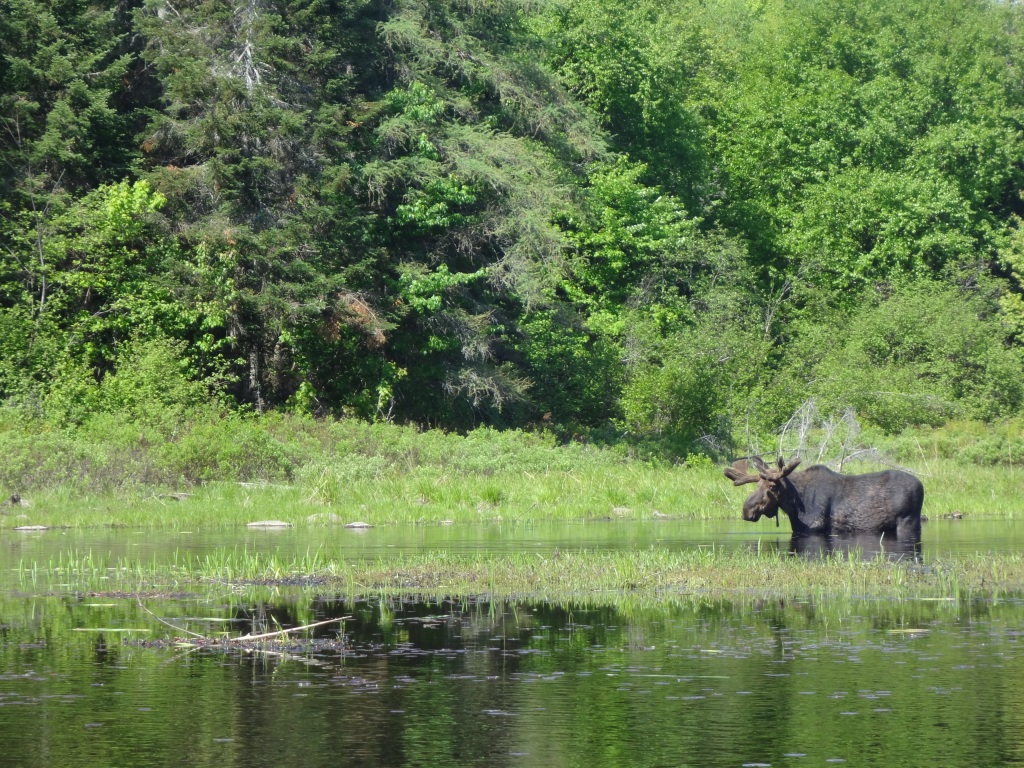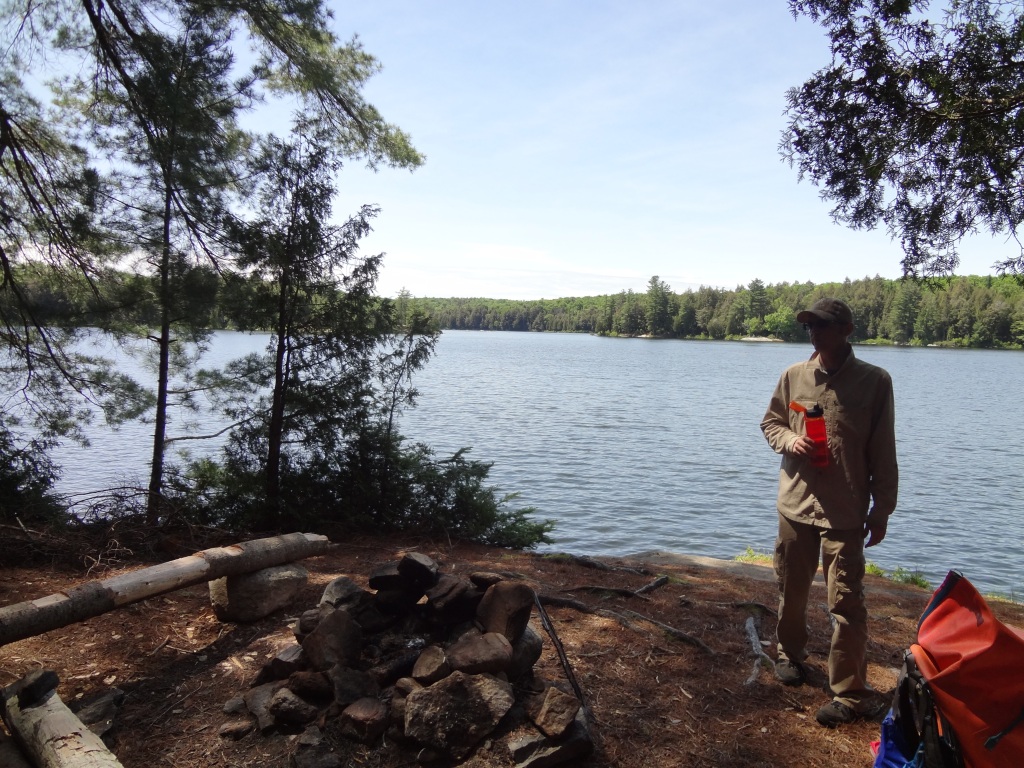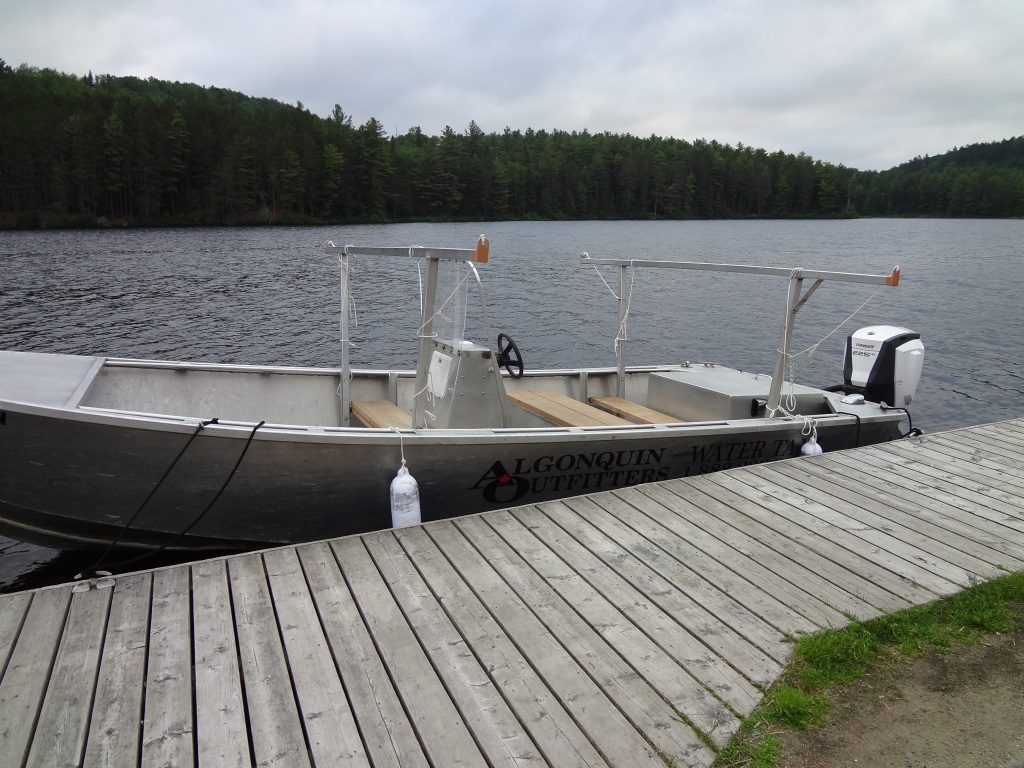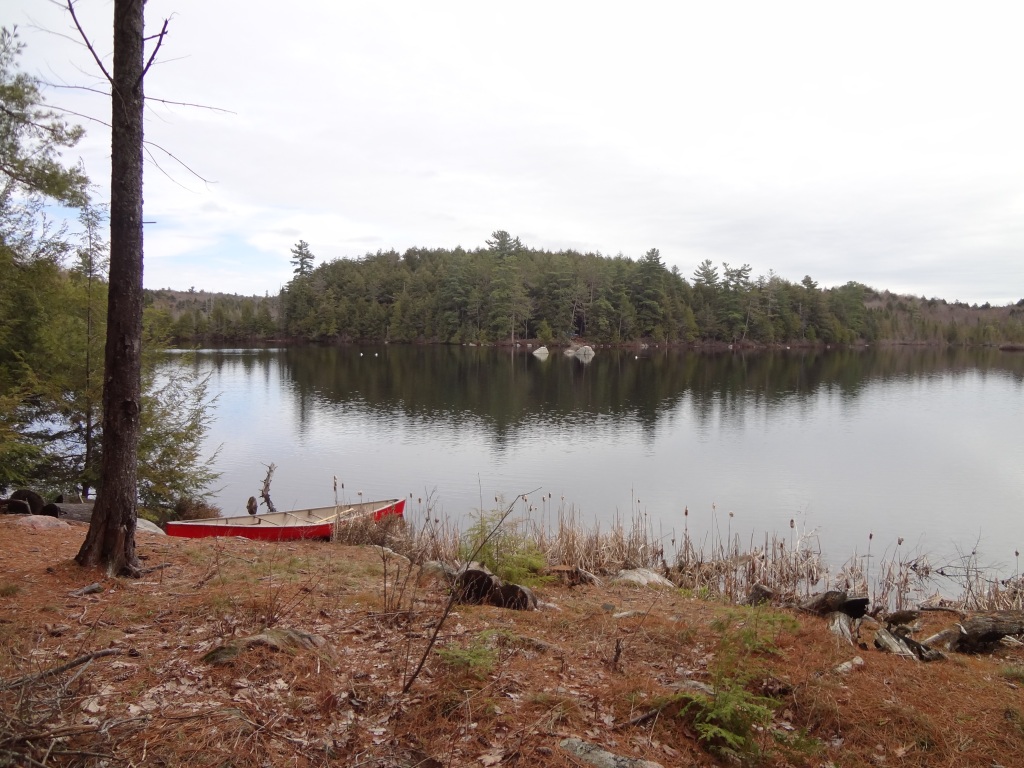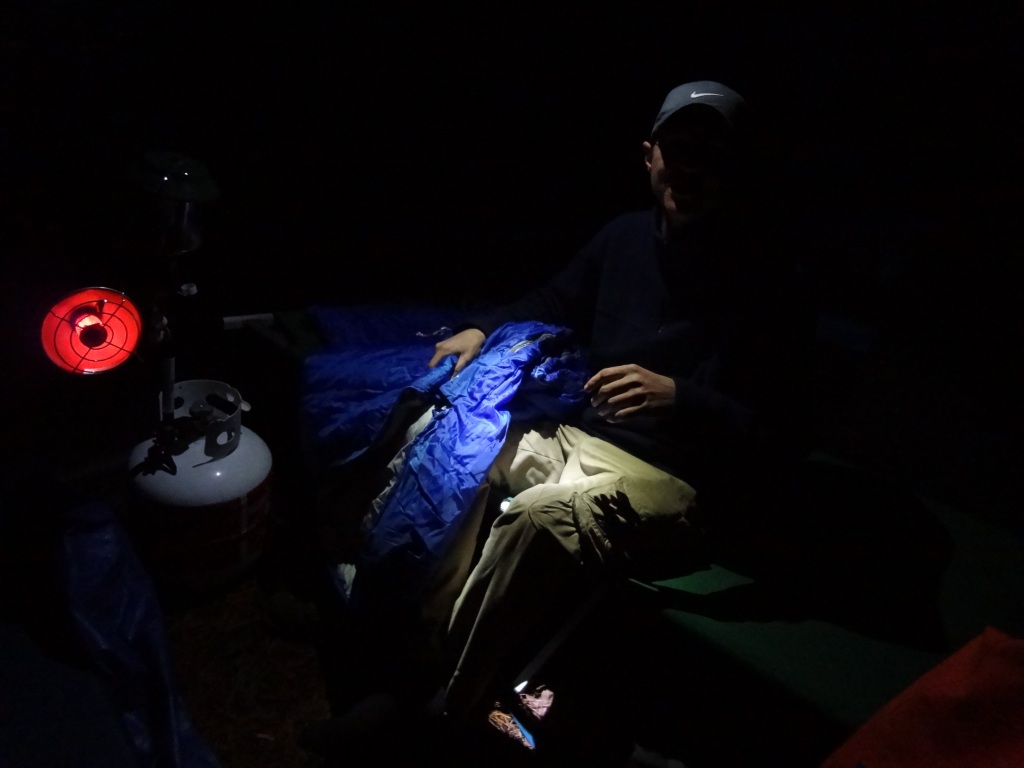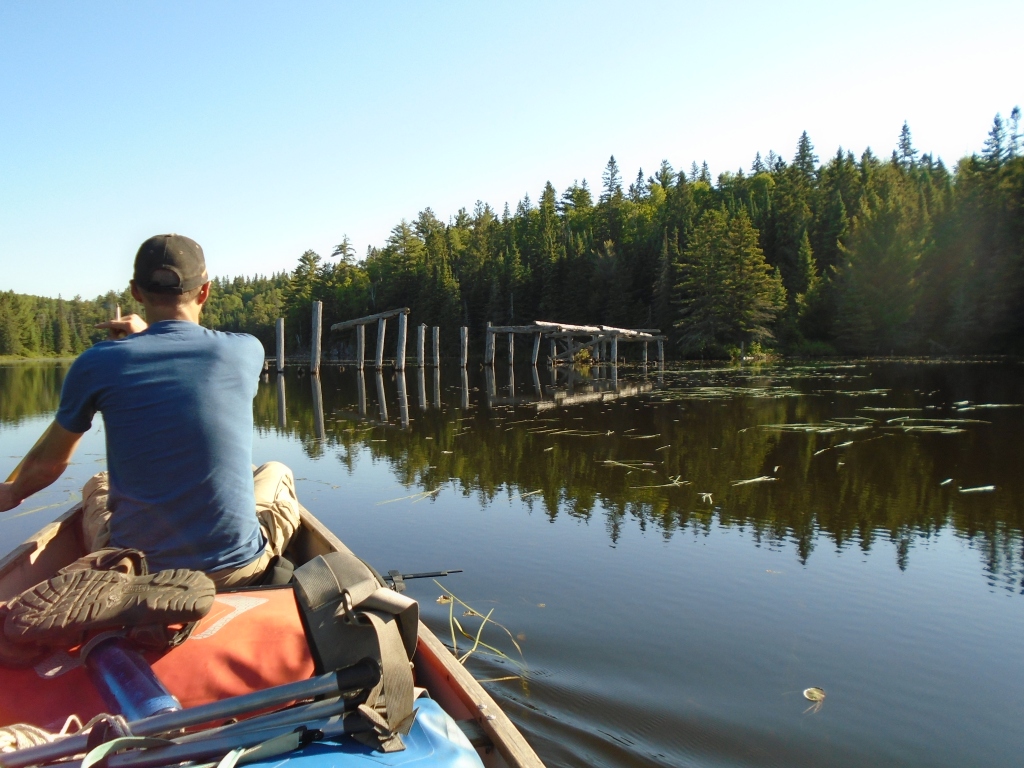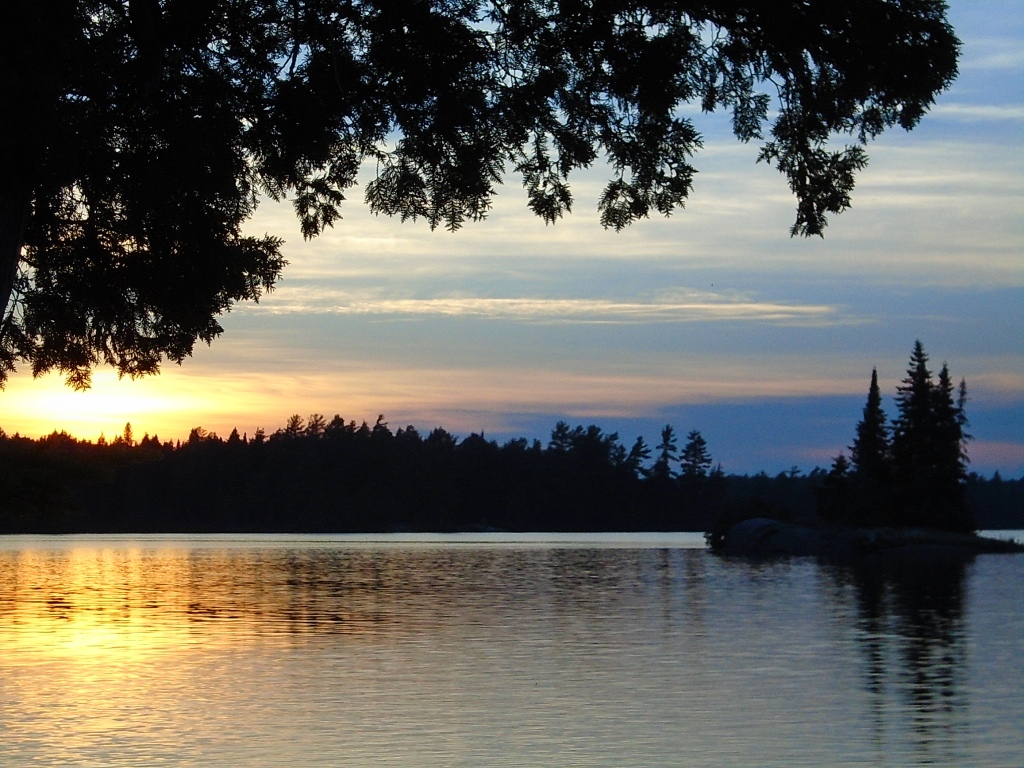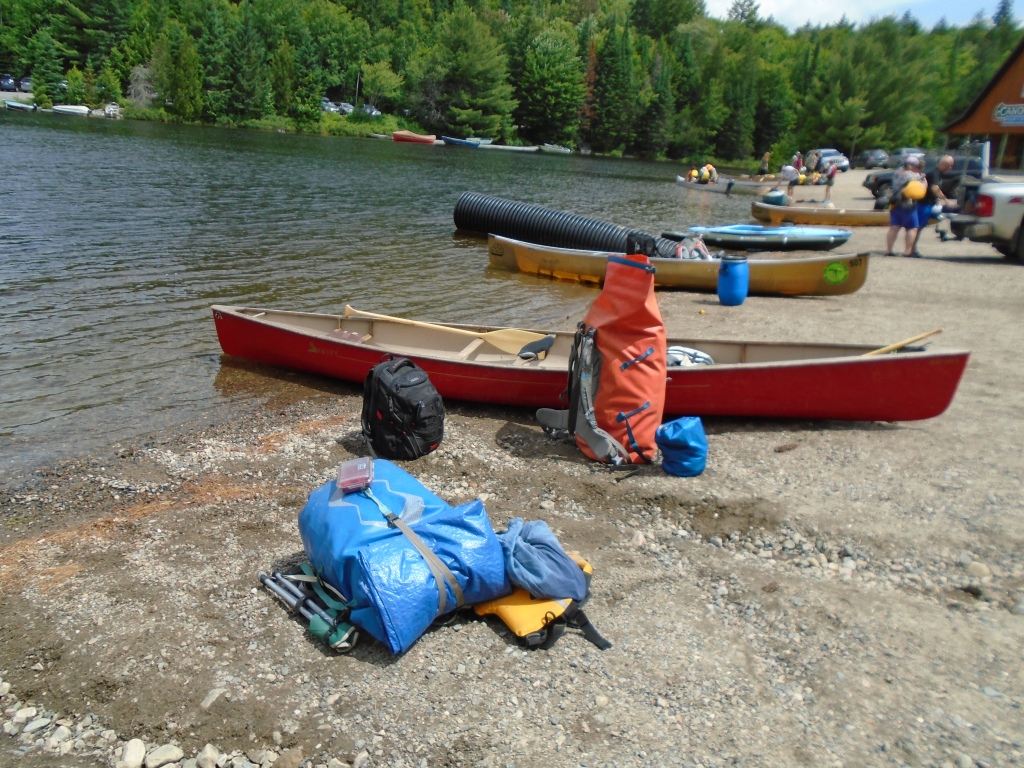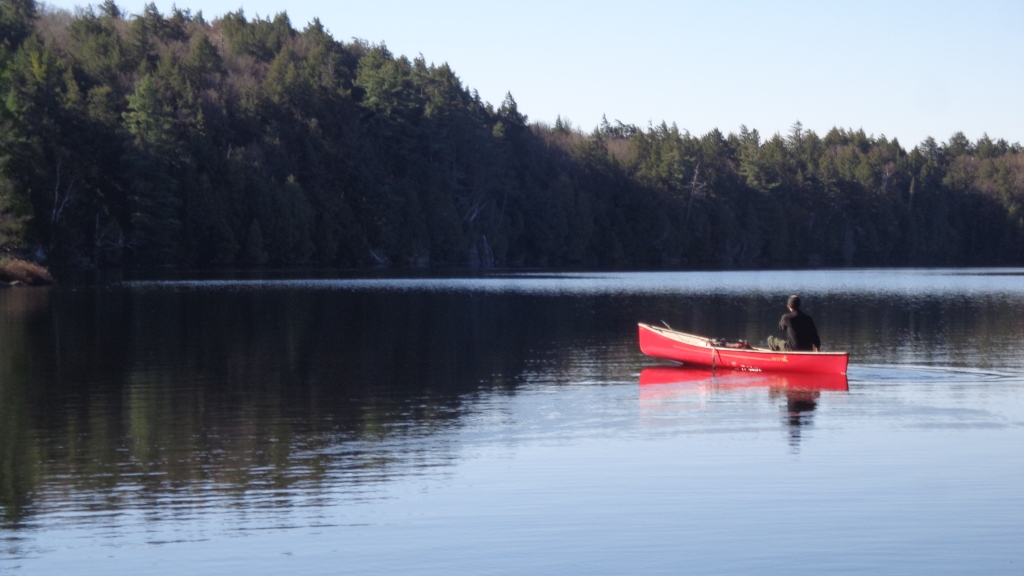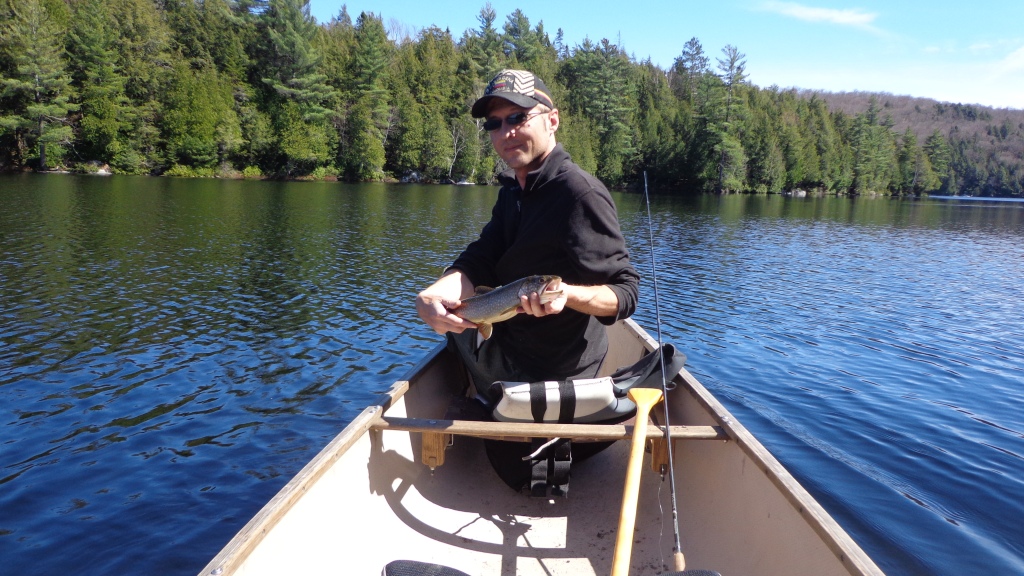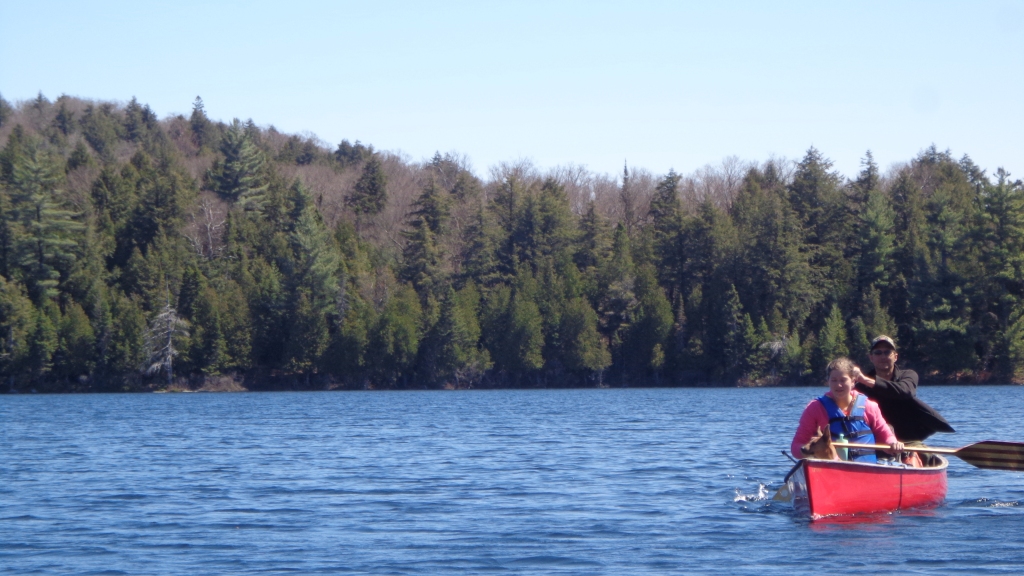May 13 – 19th 2023
# of portages: 13
Total portage distance: 7270m
Total distance: 70.6km
Video Log:
Shane and I had decided this year to try to beat the bugs and head into Algonquin as early as advanced booking would allow us. That meant that we would try to go Saturday-Saturday from the 2nd week of May forwards. The Park did wind up opening early, but the time was already booked and plans already made for the 13th, so that’s when we started. Our loop was meant to be a “vacation” loop, going to places we had been a decade or so ago, and revisiting sites we knew and loved. Our paddling distances were ones we knew were fairly mild, and we managed to knock many thousands of portage meters off our previous trips. With minimal rain in the forecast, this was shaping up to be a banger.
We met up around 830am on the 1st day at Canoe lake, ready to make a beeline to McIntosh. We tried to get out as early as possible in order to beat the predicted headwind, but a forgotten block of cheese forced me to delay our out to around 9am. Canoe lake was fine, and we paddled happily to the Joe lake portage, which we affectionately call the 401 (like the highway, because it’s so busy). This short portage was a good shakedown of our new packing systems. Both our MEC Slogg bags were a bit long in the tooth, so we decided to innovate. I was using an old Eureka 110L pack I’ve had for a while but never really streamlined. I bought a new liner from RBW, which is huuuuuge, and added an exterior pack to hold stuff like the map, fishing gear, and assorted bits and bobs I want accessible. Shane on the other hand went nuclear on the problem and bought the Watershed Patrol Carrier Pack. This bag has the same volume as the Slogg, but using a zippered top allows for much more usable room than a fold-down top. Between our two new bags, room was maximized between the two of us to the most it’s ever been. It did make for some heavy carries on the 1st day, since Shane took all the food.
Tepee Lake was just starting to blow up as we crossed into it. It wasn’t crazy, but it was definitely windy. We passed a few solo boats going the other way (with the wind), and everything calmed down once we were in the Little Oxtongue River. We dipped north into Tom Thompson and decided to crack into lunch before our only “rugged” portage of the day. This was the first time we’ve stopped on the eastern shore of T. Thompson lake, and we weren’t too impressed. Very hilly, buggy, and rocky. I guess it’s not the worst place in the Park, but there’s got to be more appealing sites in the western or northern sections of the lake. Fueled up, we headed back out into the wind and towards our portage.
We’ve done this trail many times, and it’s always the same. The first half sucks, the 2nd half is fine, and the last 50m are the worst part. I don’t like the stairs on the Ink lake side, and there’s big berm you need to crawl over in order to get to them. This time, it was an all-or-nothing hail Mary to get up that berm with the canoe, and Shane nearly had a heart attack getting the food over it. We took our time and knocked out the portage in an hour and ten minutes. Not a land-speed record, but we were in no rush and the trail was a nice place to be that day. Pushing out along Ink Creek was the usual meander, and before we knew it we were staring down the whitcaps which dotted McIntosh Lake.
Both Shane and I agree the McIntosh is one of our favorite lakes in the Park. 10 years ago it piqued our interest as we had a quick lunch on the northern island, so we decided to head back to that same spot for this trip. Again, headwind, but we island hopped our way back there taking a look at the available sites along the way. The northern site was fairly protected from the northern wind, and suited our purpose for this trip. I even managed to get 2 or 3 bars of cell service standing at the canoe takeout, which was a nice way to contact family and check the weather radar. It was around 4pm when we started unpacking the bags and setting up shop for our 2 night stay.
The wind stayed up into the evening, so I set up a wind-block tarp by the fire pit to keep comfortable. Shane set about using the kid’s rake he bought to clean up the fire pit. I was skeptical at first, but I’ll be damned if I didn’t immediately take the rake to get the pinecones off our tent pad. By the end of the trip I was converted to Team Rake whole-heartedly. Dinner that night was chicken burritos, which we did on the stove, and before we knew it the sun was down. Our shelter this trip was something fancy. About 2 months before the trip I had asked people on the Algonquin Adventures forum for advice on a new tent. I wanted something roomy enough for 3 people, and significantly more lightweight than my 3.8kg Camper 4. I found even expensive tents were only maybe 1kg lighter and significantly smaller than the current setup. Along came someone who not only suggested the Tarptent Hogback, but offered me his to try out! I was most appreciative, as this tent checked all my boxes. 1.8kg and easily big enough for 3 real humans. The cost of bringing one over from California is high, so I couldn’t say “thank you” enough. Without going too far into detail, there were a few compromises, mainly not being free-standing and relatively low in height, but it was really good for what it is.
We were also both sporting new sleeping systems. Shane had gotten a good deal on a new sleeping bag which was supposed to be good to -10, and I opted to bring two 0 degree bags instead of 1 big one. I’ll tell you, we brought these systems riiight to their limits of comfort this trip. The 1st night wasn’t too bad, with temps getting down to around 4 celsius, but I very quickly abandoned my original plan of using the smaller sleeping bag as a blanket over my longer one. Around midnight when I got up to go to the bathroom, I zipped everything up and put one bag in the other one, doubling up how comfortable I was. Shane on the other hand only had his many layers to fall back on. On McIntosh, it wasn’t so bad.

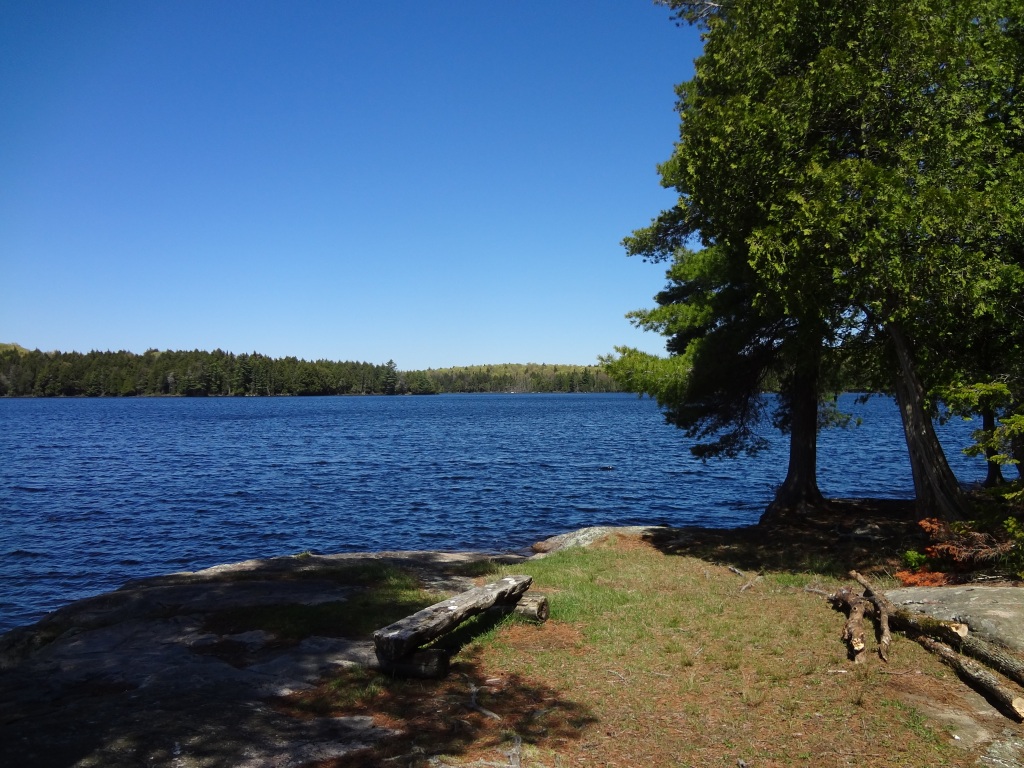

We woke up on the 2nd day well after sun-up, and to a steady wind already starting up. Breakfast was a concoction we affectionately called the “meat tornado.” We had cured bacon and smoked pork tenderloin sizzling in the pan, which we melted cheese over. This gooey, crackling, mess was then poured into a wrap and consumed greedily. It was so good we rationed some meat and decided to have it again the next day instead of pancakes. The day warmed up and we went out to get some hardwood from the mainland. Along the way we checked out the northern sites of McIntosh, which we haven’t really seen. They’re wooded and open, but not all the best. Some had great views of the lake, but mostly they were buggy and flat. With our hoard of lumber in the boat, we paddled back to our island and whiled away the afternoon. We had naps, fished from site, and enjoyed our day off. Dinner was rehydrated pulled pork over rice. It was…food. Maybe I’m not privy to the intricacies of pulled pork rehydration but it was very dry and mostly tasteless. We did get calm waters and a warm evening though, which was made better by our solid lumber situation.
Our third morning of the trip was windy. Starting to see a pattern developing? Luckily the wind was with us! A happy first for the trip. We were firmly pushed towards the set of portages into Grassy Bay and they were lovely. Generally they go downhill from McIntosh, and there’s always something to see or do. On the first portage we simply went as quickly as possible and were through to a small creek in 8 minutes. After a tastefully short paddle break, we were back overland for one of the most interesting portages I’ve come across. It’s well worn, with a picturesque set of rapids along one side for the 1st half, and then a couple of bridges over the resulting river for the 2nd half. I found myself crossing these bridges and yelling out “this is cool!” on more than one occasion. If I were a more resolved photographer, these sections would make for some Instagram-worthy action shots. Since I’m not on Instagram so they’re not worth taking the boat off for.
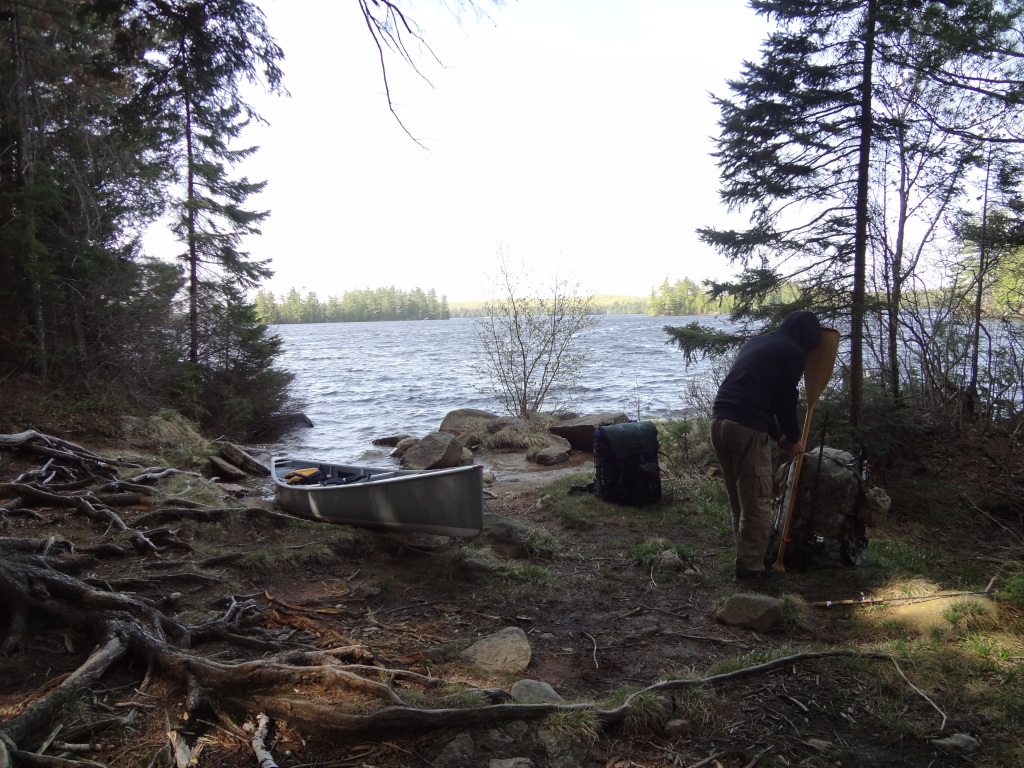
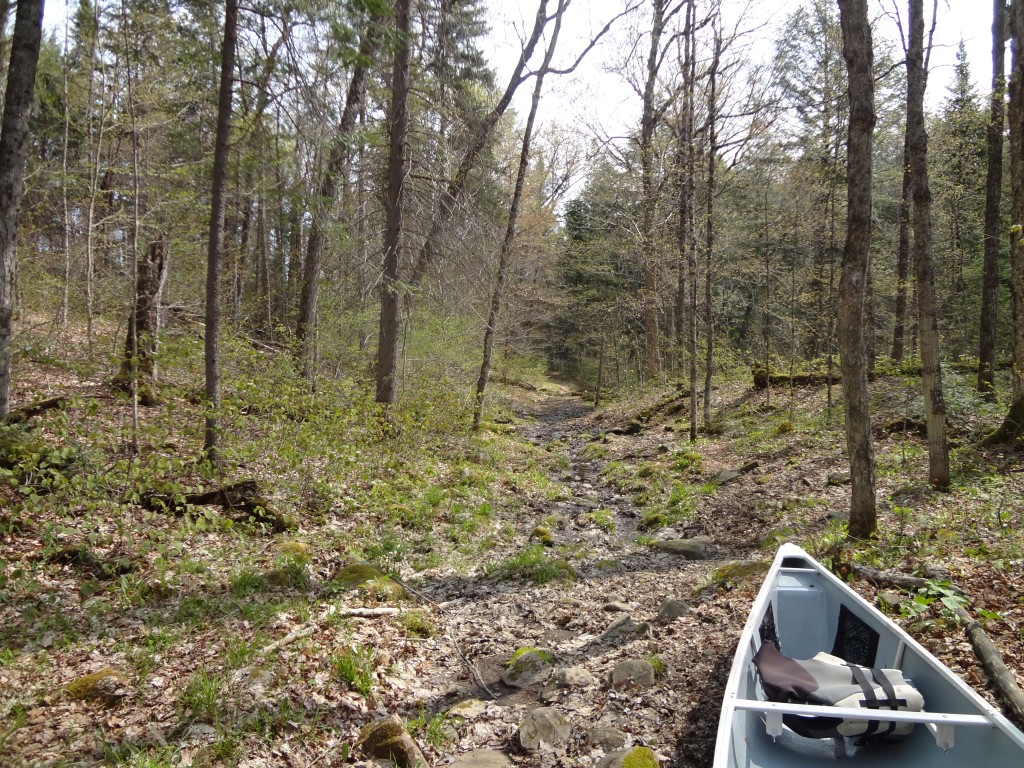

Back on the water we were hit in rapid succession by a series of increasingly large beaver dams. One even had a small portage around it, but a series of shimmies, shakes, and the occasional skateboard-style kick got us through without unloading the boat. We saw our first moose as Grassy Bay opened up, and the wind really started a-blowin’. The weather radio called for sustained winds in the 30s, with gusts blowing up to 60km/hr. On shore, that’s manageable. In a little canoe, that’s stressful. We blew and bobbed our way west, with the plan being to stop for lunch on the site just south of the Petawawa confluence from the north. By the time we got there, the wind was a real factor regarding where we were pointed and where we went, so we had to bypass the site in case there were people on it. Split-second decision, and there was no going back once we made it. White Trout lake was better, but not by much. We took the western island site, mid-way up the lake, as it was the most sheltered site we could see. The northern sites may have offered more protection but we were tired and hungry from the morning paddle. It was getting to the point that we were starting to bicker over small stuff like where to take out the canoe, so we really needed a break.


Our site was hard to get to from the water. The southern edge of the thin island has the proper takeout, but high waters and hammering winds made the decision for us to paddle to the protected bay on the other side and ‘schwack a way up in the calm lee. Our firepit was behind an ever-so-slightly raised berm which was the perfect wind-block when coupled with the trees on it. We quickly set about eating a pepperette wrap (elk I believe) and drinking some much-needed water. After a few minutes rest, we felt up to exploring the eastern side of the island a bit in search of photo opportunities and firewood.
Wandering along a well-worn path to the east we found quite a cache of wood from a fallen tree. We decided to push a bit farther, and we were rewarded by being scared witless by a duck. Apparently, this brown duck had a nest and eggs well up and away from the water and was put out by our intrusion. It made for a fun story, but we definitely didn’t look cool. We spent an hour lugging our precious lumber back to the firepit for processing down and splitting, which took a good chunk of our afternoon. Before long the sun was going down (don’t worry, the wind stayed up) and we had our first spaghetti dinner of the trip. Always a favorite, it was nice to have before a colder night and a real morale-raising meal.

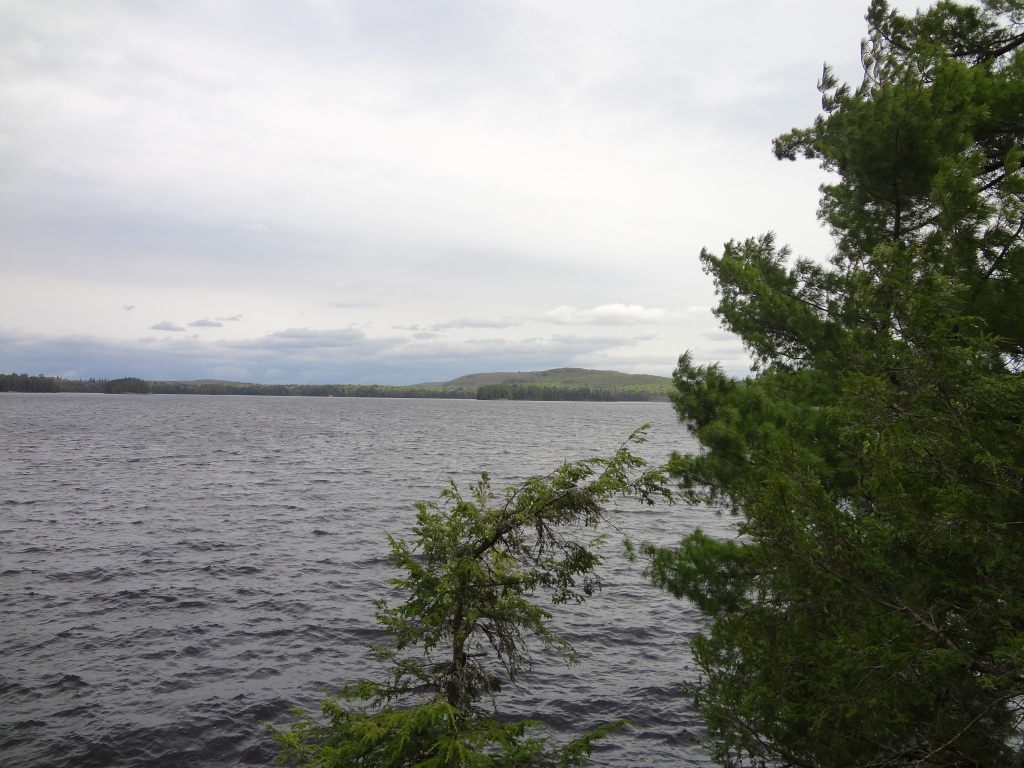
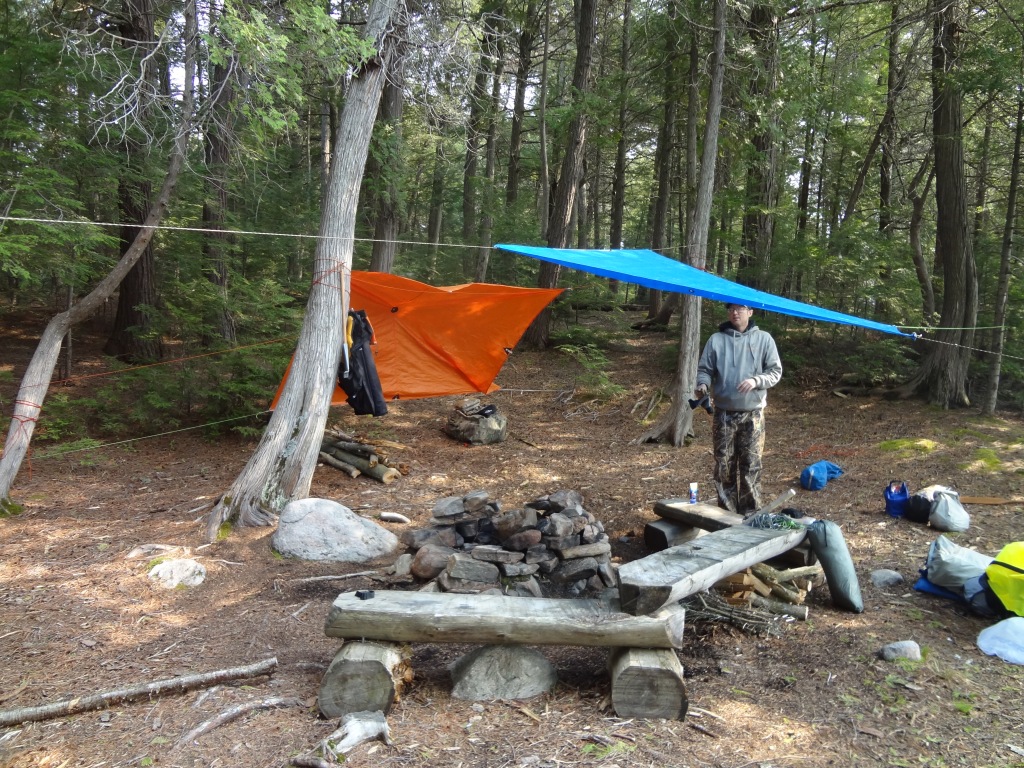
We woke up early and got on the way as quick as we could on day 4. We were travelling, but only 1 lake east and there was NO portaging! It was a lovely novelty. Our weather radio was telling us that the wind was going to shift in the morning from out of the west to out of the north, so we wanted to be pushed eastward while we could and avoid an headwinds. The wind wasn’t too bad early in the morning, but it was definitely present. We had never been through the narrows between the two “Trout” lakes, and while the narrows was pretty lackluster the cliffs on the north end of White Trout are something to behold. They just come out of nowhere and they’re spectacular. There’s no way I can convey through words and pictures how imposing they are, but they are absolutely something to see if you’re in the area.
We popped our heads into Big Trout within an hour of setting off, and went north to the sites marked as “Birch Point” from Jeff’s Map. The site was great: beachy, spacious, rocky, picturesque. But it also was aligned way more north-south than we wanted. According to the weather report, the wind was going to be up all day and night, bringing the overnight low to -11 Celcius and we wanted to be as protected as possible in order to have a chance of enjoying ourselves. We turned around and started heading south, settling on the first multi-site island as you come out of the narrows. The sourthern-most site was simple, tarpable, easy to get in and out of, and protected! Between the narrow channel in front of us and the big hill behind us, this site was as good as we were going to get.



We put up the tent and tarps as soon as we settled on the site being our home. There was weather rolling in and one thing we didn’t want to be was cold and wet. Cold you can fix, and wet you can fix, but cold and wet together can be dicey this time of year. We then took some time to explore the well-worn paths around the island. We found the unofficial lean-to site on the eastern side, and a flagging-tape trail to the northern site. What a miserable place the northern site was, especially on that day. It consisted of large logs that park staff had cut with chainsaws, rocks, and hills. Maybe one good flat tent site. Also, wind had shifted out of the north and was blowing right down that site’s mainstreet. Really a miserable place to be that day. We hiked back to our site just as a seven-canoe crew rolled into an adjacent site for a lunch break, and then the rain came down. It wasn’t too heavy or around for a while, but it wouldn’t be pleasant to be out in.
After lunch, we set our minds to rearranging the tarps to be a wind block rather than a rain cover. It took some arranging, but with teamwork and the help of the canoe we managed to get a good chunk of the biting wind out of our site. We had gathered plenty of wood for the night and sort of managed to relax a bit before the sun went down. Dinner was New Mexico stew, a hearty and warming soup but very…bean forward. Let’s just say you need to be comfortable with your tripping partner and bodily functions with that menu item. The sun went down and the temps plummeted. Shane went to the comfort of his sleeping bag early so that he could make sure everything was set up perfectly, while I stayed up and read my book by the fire. I eventually turned in as my book started to get to a dark and spooky part (not great for reading alone on a cold, windy night).
That night was really quite cold. Getting up to go to the bathroom sucked. Doing it multiple times wasn’t fun either. There was a light snow overnight, with only the smallest amount staying in the shade the next morning (but it was there!). There was also a good chunk of ice in the sink, so I’m glad I put our water filter in between my two sleeping bags for the night. We slept in until mid-morning in order to enjoy our sleeping bags’ warmth for a while, but the 5th morning of our trip was crisp and clear. It wasn’t supposed to be warm, just 9 degrees, but we knew this was a travel day. We were scheduled to stay another night on Big Trout, but the weather was dictating our schedule now. With favorable winds today, a nice day tomorrow, and fading weather for the end of the week, we wanted to push to cross Burnt Island on day 6 and not worry about getting windbound. Burnt Island is one of the few lakes where you can very much face a western wind barreling down an 8km lake unimpeded and I didn’t want to see it.

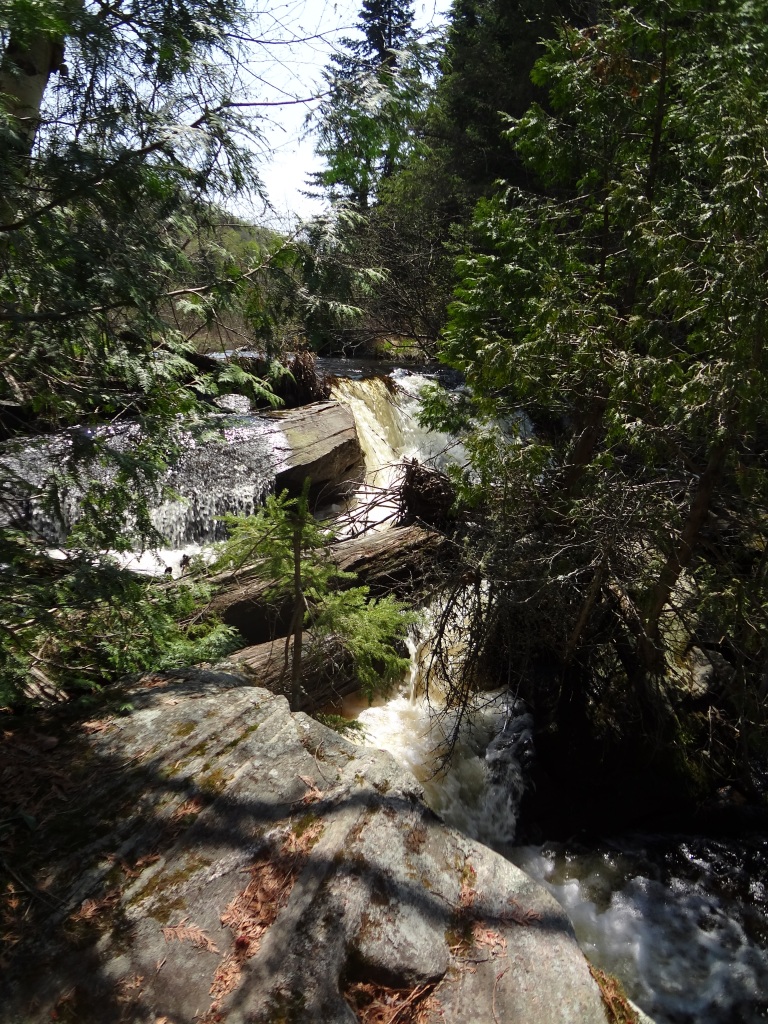
Our minds made up, we kicked off our nice and sheltered site just before noon. The sun was high, and the wind was…well, it was blowing but it seemed to be going the way we wanted and not as strong as earlier in the morning. We looked at the whitecaps skeptically, but the paddle was actually a doddle compared to the crossing of Grassy Bay. Where we previously had to pry and fight the boat to stay straight and level, here we gently bobbed our way across the bigger water. No stress, no mess. At the first of five portages up Otterslide creek, we stopped to take off layers and have a bite to eat. With no wind, the 6 degree heat felt downright balmy.
I genuinely loved travelling up Otterslide creek. At this time of year it’s an amazing part of the Park. The water moves gently enough to not be a tough paddle, and the wildlife is vibrant. We saw a variety of birds, fish, and a young cow moose. The portages were in great shape, and significantly easier than somewhere like Maple Creek. It’s like the Crow River, but easier and shorter. We managed to get to Otterslide lake by 430pm, easily the latest we had ever pushed into a lake, but we were feeling good and strong. As with before, we wanted a protected site. The comfort of getting out of the wind for a fire and shiver-free sleep cannot be understated to our mental health.


So we started trolling for sites on Otterslide lake. We started with the obvious one right in front of us in the northwest corner of the lake. The bigger “party” site looked fine and had a great view of the almost mountainous lake in front of it, but it was a warm-weather site. Further down we saw more sites and further disappointment. The closest thing to good site for us was on the north-western island, but there wasn’t a flat and level tent pad and we were feeling picky. So we headed towards our portage for tomorrow morning on Little Otterslide. We figured the smaller the lake, the less wind we’d feel.
Little Otterslide was…weird. Something felt off with the shape and the layout. Much like it’s bigger brother, Little Otterslide is populated by big rocky sites and cramped wooded ones. There’s big empty bays and long vistas into nowhere. Now I understand when people say “meh” to the Otterslides, and I really wanted to like these lakes. Oh well. We eventually hung our shingle on the second-to-last northern site before the portage. What this site had was protection, and little else. At least that’s what we thought initially.
What I came to name “The Little Campsite that Could” was nothing spectacular. There was nowhere easy to pull up the boat, there was moose poop all over the place, the firepit and tent pads were way back in the woods (which is what we actually wanted), the thunderbox was down a spooky tunnel of pine, and the benches at the firepit were just some vaguely flat logs. In a few weeks this would be a bug-infested sweatbox. While we were there, it was perfect. This ugly duckling was overflowing with quality lumber that required next to no processing. You just went out and broke off enough to satisfy your immediate needs from one of the fallen trees just off the site. Once the firepit was cleaned up, there was enough room for us to both relax and enjoy the BTUs. With the undergrowth still not quite in bloom we could see the water from the warm fire, and stargaze from our dinner seats. Best of all, not a breath of wind made it to our site. Once the sun went down and everyone in the forest shut up for the night, it was just us in the warm glow of the fire and the stars overhead. We had a late dinner of Hamburger Helper with dehydrated ground turkey and some vegetables, then went to bed content and happy to have a night above 0 (2 whole degrees!).

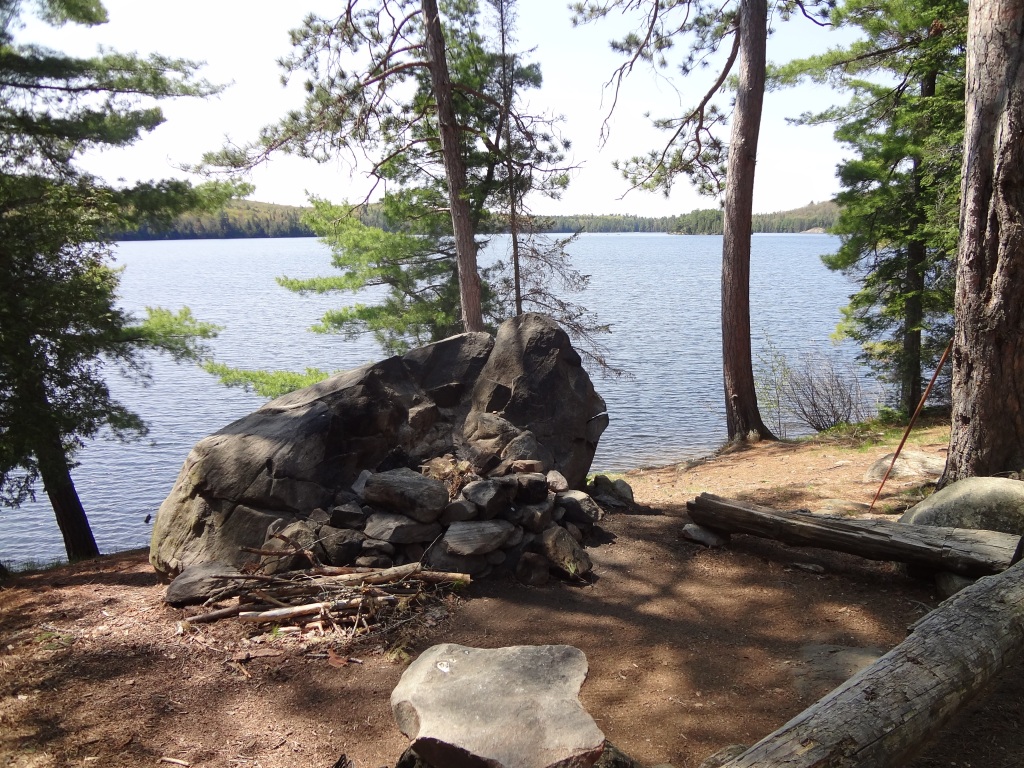
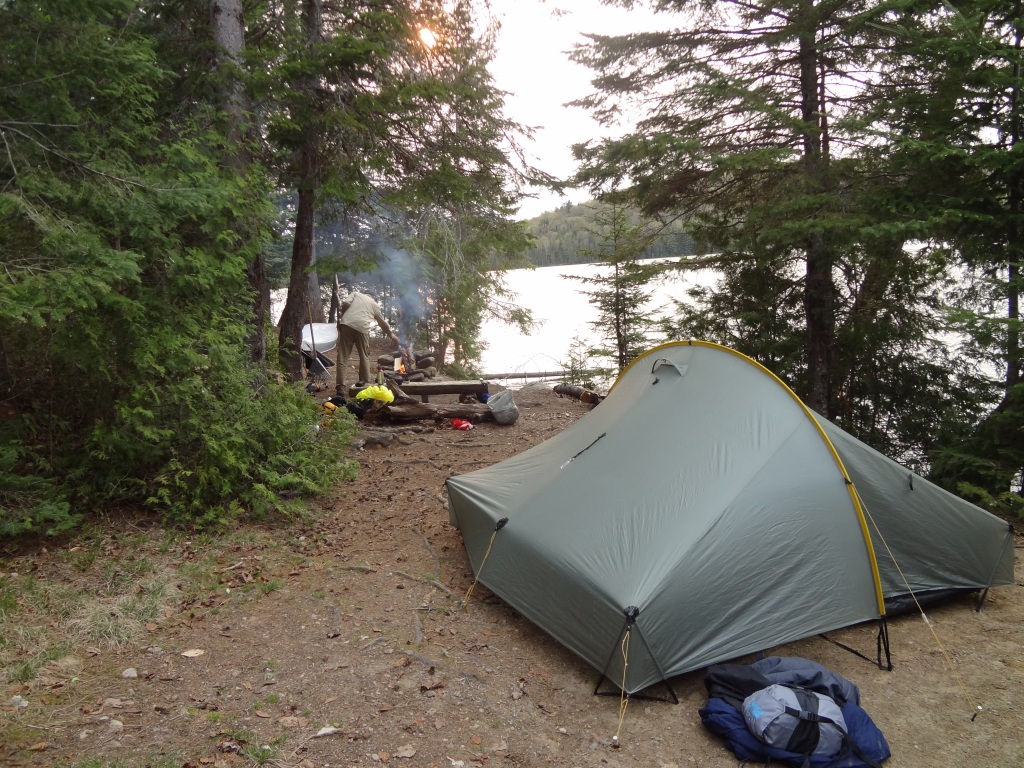
We got up pretty early on our 6th morning. Rather than cooking a hot breakfast, we opted to munch a few Clif bars with our coffee to cut down the cleanup time and expedite the packing process. The sun was out, the day was warming quickly, and we wanted to get across Burnt Island as soon as possible. Before long we were starting up the last “real” portage of our trip before the Hwy 60 corridor shows it’s face. The Otterslide side of the portage is rocky and flat, a real ankle breaker. But about halfway through it becomes a relatively wide and very smooth trail, easy as can be. We took a break to enjoy ourselves, but it only took us 20 minutes from boat up to boat down between the lakes, and it was well worth the effort. Burnt Island looked warm, flat, and welcoming! I was excited to make miles.
Travelling the length of B. Island took about an hour and a half of straight and steady paddling. We took in the sights, as well as the sites, that we passed and immediately saw the appeal this lake has had to humanity over the past century and a half. It’s a gorgeous lake when docile, and the sites seemed well-developed and spacious. It is definitely a lake which I can see myself taking the family to for a long weekend. Just far enough away from the highway be an adventure, but close enough to make getting in/out an easy morning. We made for arguably the most popular site on the lake, an island on the western side right in the middle of the lake. The wind was steadily rising out of the west but we were curious about what made this site “great.” It’s easy to see why it’s popular. There’s spectacular views from the fire pit, which itself if raised into a large stone. The tent pads are grassy and flat. The water is clear and blue the whole way around the island. What’s not to love?
We wound up spending some time on the island, taking in lunch and trying some fishing. Shane cleaned out and rebuilt the firepit. The wind continued to blow through the site, and later in the afternoon we made the executive decision to move to the south-western shore sites. We knew the site would be of inferior quality, but the cover from the wind and extra few steps towards Canoe lake made it more desirable. If the wind blows up and we’re warm, we win. If it stays down and we are simply closer to the portage tomorrow (having paddled in ideal conditions), we still win. Our last site was small, and showed signs of abusive campers throwing trash all over the place already, but a quick cleanup made it homey. Flat and by the water, it gave us a good place for a small group, nothing to rave or complain about. What I did enjoy was the thunderbox. Just a short walk down a path brings you to it, and the view into the hardwood was generally pleasant. After a final spaghetti dinner, we turned in to our first “warm” night in a few days.
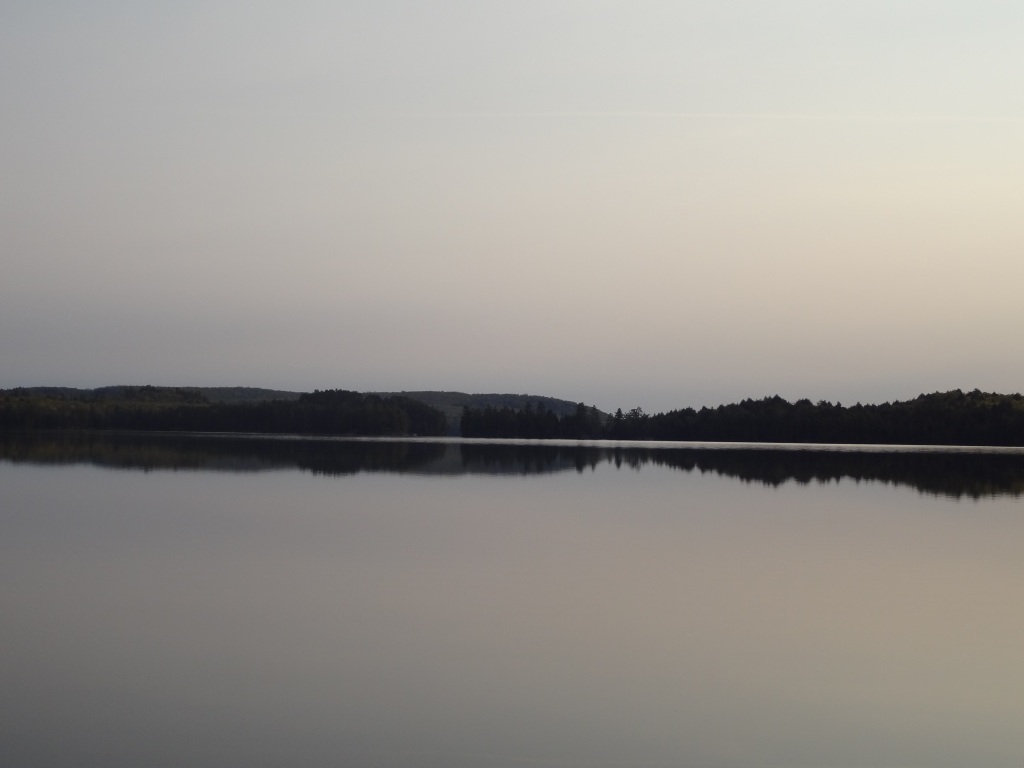


Our final morning was an early one. We knew the wind was going to be coming out of the south, and the later we left it the worse it would get. Gusting up to 50km/hr in the afternoon and rain in the forecast. This meant that we were motivated to move. After a breakfast of whatever dry food was left (a pepperette, rice crispy square, and granola bar each) we broke camp and headed back towards the Joe lakes. The last time I was through this part of the park was 9 years ago, and to be honest the weekend was pretty blurry. But I remember the portages being a doddle. If anything, they’ve gotten even easier, with better signage and more footsteps wearing it in. None of the portages between B. Island and Canoe lake took us more than 10 minutes to get through, which is a testament to how fast you can go with no consumables to weigh you down and not needing to worry about your footing.
It was nice to see old sites and areas we hadn’t been to in a while. Seeing the Arowhon Lodge and all the high-use sites was a neat reminder of what we usually blow by in our search for solitude. These sites are absolutely picked over and hammered in by human activity, and to be honest they weren’t appealing to me at all. I’d rather spend another hour paddling to get to a less-used part of the park, but understand the appeal of these places to a wider spectrum of people.
We pulled into the gravel beach of Canoe Lake’s put-in among a few other groups going in and out. It was the long weekend, so we expected more groups, but it wasn’t a zoo. We had made it through, wind and cold be damned. We had cut a day off our trip, but the rain which eventually came through the night was reason enough to do it. The weather dampened what was supposed to be a vacation and turned it into an adventure. We didn’t get in as much exploring or fishing as I had hoped, but the cliffs of White Trout Lake and our travel up Otterslide creek made the trip worthwhile for me. It was good to see parts of the park which were adjacent to our previously travelled paths. And there were no bugs! In MAY!
Great trip, can’t wait for the next one.



